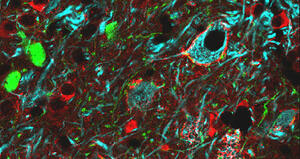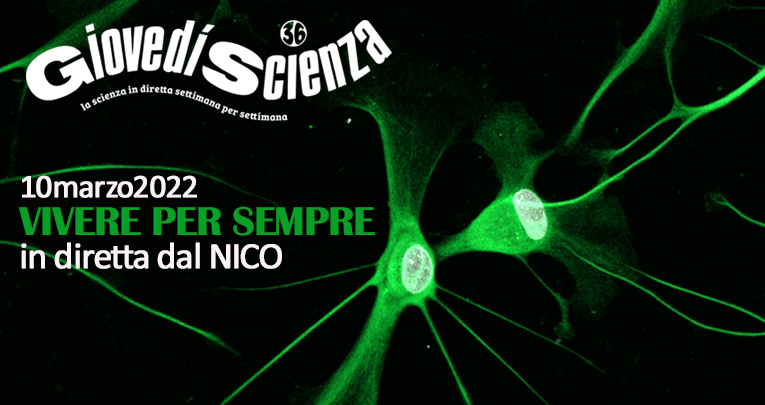NICO Progress Report
INN Open Neuroscience Forum
L'appuntamento con i nostri ricercatori continua nel 2018, ogni due venerdì alle 14:00 in sala Seminari
Prossimi appuntamenti:
mercoledì 31 ottobre - ore 14:00
Simona Perga (Gruppo Bertolotto)
The anti-inflammatory enzyme A20 the brain tissues of Multiple Sclerosis patients
Calendario 2018
19 ottobre
Mattia Ghigo (Gruppo Eva)
The long lasting effect of early life stress in mPFC. Perineuronal nets expression in a gene/environment interaction murine model
21 settembre
Marco Fogli (Gruppo Buffo-Luzzati)
Dynamics of striatal astrocytes neurogenic activation and functional properties of their neuronal progeny
7 settembre
Gianmarco Pallavicini (Gruppo Di Cunto)
Does KBP (KIAA1279) control midbody microtubule stability likewise CIT?
20 luglio
Chiara La Rosa (Gruppo Bonfanti - Peretto)
CORTICAL LAYER II IMMATURE NEURONS ARE HETEROGENEOUS IN MAMMALS
The doublecortin-positive (DCX+) pre-natally generated neurons discovered in the layer II of the rodent piriform cortex are considered a reservoir of “immature” neurons in the adult brain. In some non-rodent species they extend into neocortex and in sheep also into subcortical regions. Hence, immature neurons might be more important in large-brained, long-living mammals. We assessed the occurrence, distribution and amount (linear density - cells/mm of layer II) of type 1 (small-bipolar) and type 2 (large-ramified) DCX+ cortical neurons at 4 comparable brain levels in 13 mammalian species endowed with different brain anatomy, lifespan, ecological niche. Sections were immunostained for cell proliferation (Ki-67, BrdU) and immaturity/maturity markers (PSA-NCAM, NeuN). All non-rodent species considered hosted DCX+ neurons in neocortex, with highly heterogeneous linear densities. By contrast, morphological and phenotypic features were rather constant: type 2 cells represented 10-20% of the total, mostly expressing NeuN, whereas 15-30% of DCX+ cells were also PSA-NCAM+. BrdU and Ki-67 antigen detection confirmed that all DCX+ neurons were non-newly generated/not proliferating. These results show that “immature” cortical neurons do represent a well preserved, yet, highly heterogeneous feature in mammals, especially considering rodent and non-rodent species.
6 luglio
Roberta Parolisi (Gruppo Buffo)
Characterization of the action of extracellular vesicles derived from microglia on OPCs
EVs, being spontaneously produced by cells and containing a heterogeneous range of molecules, are emerging key mediators of intercellular communication.
We are studying the role of these vesicles released from alternatively activated microglia, on in vitro OPC proliferation and differentiation, and in vivo re-myelination after toxic demyelination
22 giugno
Marina Boido (Gruppo Vercelli)
Unraveling the role of Nurr1 in a murine model of Amyotrophic Lateral Sclerosis
8 giugno
Giulia Nato (Gruppo Buffo)
25 maggio
Valentina Cerrato (Gruppo Buffo)
Clonal analysis: things you should know before going into it
10 maggio
Gaia Berto (Gruppo Di Cunto)
TTC3: a Down Syndrome gene involved in neuronal migration
Down syndrome (DS) is caused by trisomy of Human Chromosome 21 (HSA21). The clinical manifestations of DS vary in both penetrance and intensity among affected individuals, but the only hallmark common to all patients is intellectual disability (ID).
DS-associated ID is the result of developmental brain abnormalities, leading to altered neuronal migration and connections within the cortex. One likely candidate for these phenotypes is TTC3, a HSA21 protein, whose expression is increased in cells derived from DS experimental models and from DS patients. Moreover, up-regulation of TTC3 inhibits neuronal differentiation by modulating actin cytoskeleton. In this last years, we are studying the effect of TTC3 over-dosage in cortical development, up-regulating the protein using in utero electroporation and we demonstrated that TTC3 levels are critical for correct neuronal positioning within the cortex. These data support the hypothesis that DS-cortical phenotypes can be ascribed to the increased dosage of TTC3.
27 aprile
Eriola Hoxha (Gruppo Tempia)
Role of Elovl5 for proper neuronal function
5 aprile
Ilaria Bertocchi (Gruppo Eva)
A possible link between NPY-Y1R transmission and the expression of neuronal plasticity inhibitors in the limbic system
16 marzo
Francesca Montarolo (Gruppo Bertolotto)
Nuclear Receptor 4 A subfamily (NR4As) in Multiple Sclerosis patients: from blood to central nervous system
16 febbraio
Isabella Crisci (Gruppo De Marchis)
The transcription factor COUP-TFI in the adult hippocampal neurogenesis
26 gennaio
Roberta Schellino (Gruppo Vercelli)
Grafting human ES cells into a rat model of Huntington’s Disease
12 gennaio
Giovanna Ponti (Gruppo Panzica)
Sexual dimorphic features in SVZ-OB system are permanently affected by early postnatal genistein treatment
Calendario 2017
22 dicembre - Gianmarco Pallavicini (Gruppo Di Cunto)
Citron kinase inactivation inhibits medulloblastoma progression
15 dicembre - Alice Farinetti (Gruppo Panzica)
Sexually dimorphic effect of the maternal separation on anorexic rats
7 dicembre - Simona Perga (Gruppo Bertolotto)
The anti-inflammatory enzyme TNFAIP3/A20 in the pathogenesis of Multiple Sclerosis
17 novembre - Martina Lorenzati (Gruppo Vercelli)
Axo-glial interplay in oligodendrocytes specification and myelination: role of JNK1
10 novembre - Marwa El Soury (Gruppo Geuna)
Role played by Soluble NRG1 in immediate responses to peripheral nerve injury
3 novembre - Ilaria Bertocchi (gruppo Eva)
Dynamic distribution of a fear memory engram
15 settembre - Giulia Nato (Gruppo Buffo)
Uncovering the neurogenic potential of striatal astrocytes
1° settembre - A. Adelaide Chiotto (Gruppo Di Cunto)
Cortical defects in a mouse model of Down syndrome: the role of TTC3 gene
10 febbraio -Enrica Boda (Gruppo Buffo)
Heterogeneity in the oligodendrocyte progenitor cell (OPC) pool: lessons from a microcephaly model
24 febbraio - Rebecca Gabriele (Gruppo Tempia)
Elovl5 -/- mice as a model of spinocerebellar ataxia
10 marzo - Federico Bianchi (Gruppo Di Cunto)
Citron Kinase deficiency leads to chromosomal instability and TP53-sensitive microcephaly
24 marzo - Chiara La Rosa (Gruppo Bonfanti)
Structural plasticity in the brain parenchyma of different mammals
7 aprile - Marina Boido (Gruppo Vercelli)
From muscle to spinal cord: therapeutic approaches for Spinal Muscular Atrophy
21 aprile - Roberta Parolisi (Gruppo Buffo)
Microglia-derived extracellular vesicles regulate the proliferation and differentiation of oligodendrocyte precursor cells
5 maggio - Gaia Berto (Gruppo Di Cunto)
TTC3: a Down syndrome gene involved in neuronal migration
19 maggio - Francesca Montarolo (Gruppo Bertolotto)
Nuclear receptor related 1 protein (Nurr1) in attention deficit hyperactivity disorder (ADHD): searching for a disease murine model
1 giugno - Valentina Cerrato (Gruppo Buffo)
Astrogliogenesis in the cerebellum results from progenitors with distinct fate potencies and proliferative behaviors
9 giugno - Sara Trova (Gruppo Peretto)
The Olfactory System Physiological Plasticity underlying reproduction
16 giugno - Marilena Marraudino (Gruppo Panzica)
Kisspeptin innervation of the Hypothalamic Paraventricular Nucleus: key for reproductive and metabolic control. Effects of postnatal exposure to Genistein
30 giugno - Matilde Ghibaudi (Gruppo Vercelli)
miRNAs and biomimetic scaffolds as potential strategies in SCI
14 luglio - Roberta Schellino (Gruppo Vercelli)
Pharmacological JNK-pathway inhibition reduces severity of Spinal Muscular Atrophy (SMA)
Agenda
Area Ricercatori
Guarda il video
GiovedìScienza racconta la ricerca al NICO
Vivere per sempre.
Una popolazione sempre più longeva, i suoi problemi e le risposte della ricerca
Hai perso la diretta? Guarda ora il video di GiovedìScienza al NICO: una puntata in diretta dai nostri laboratori dedicata alla ricerca sull'invecchiamento.











